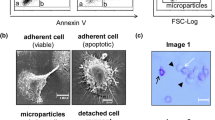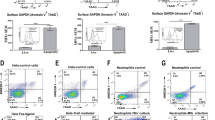Abstract
Apoptotic cells and phagocytes have developed a diverse array of distinct ligand-receptor systems that drive the recognition and uptake of dying cells. Phagocytes recognize apoptotic cells either directly, by binding to specific ligands at their cell surface, or indirectly, by binding to bridging proteins that bind these ligands. Previous observations showed that the plasma bridging protein β 2GP1, binds PS containing vesicles, and enhances their binding and engulfment by phagocytes in vitro. In this study we show that apoptotic cells injected intravenously and intraperitonealy into syngeneic mice recruited the PS binding protein, β 2GP1. Examination of peritoneal exudates and spleen thin sections showed that only the injected apoptotic cells picked up endogenous β 2GP1. Recovery of cells from the peritoneum showed that apoptotic cells bearing β 2GP1 were clustered around host peritoneal phagocytes. In addition, tissue sections from mice injected with Fas antibody showed colocalization of β 2GP1 with TUNEL-positive apoptotic cells. These results provide evidence that endogenous β 2GP1 binds apoptotic cells in vivo, suggesting that the protein plays an important physiologic role in the recognition of dying cells.
Similar content being viewed by others
Abbreviations
- ActD:
-
actinomycin D
- β 2GP1:
-
beta-2-glycopro- tein 1
- PC:
-
phosphatidylcholine
- PS:
-
phosphatidylserine
- ROS:
-
reactive oxygen species
References
Wajant H. The Fas signaling pathway: More than a paradigm. Science 2002; 296: 1635–1636
Wang X. The expanding role of mitochondria in apoptosis. Genes Dev 2001; 15: 2922–2933
Cai J, Jones DP. Mitochondrial redox signaling during apoptosis. J Bioenerg Biomembr 1999; 31: 327–334
Chandra J, Samali A, Orrenius S. Triggering and modulation of apoptosis by oxidative stress. Free Radic Biol Med 2000; 29: 323–333
Henson PM, Bratton DL, Fadok VA. Apoptotic cell removal. Curr Biol 2001; 11: R795–R805
Savill J, Dransfield I, Gregory C, Haslett C. A blast from the past: Clearance of apoptotic cells regulates immune responses. [Review] [125 refs]. Nature Reviews Immunology 2002; 2(12): 965–75
Balasubramanian K, Schroit AJ. Aminophospholipid asymmetry: A matter of life and death. Annu Rev Physiol 2003; 65: 701–734
Ravichandran KS. “Recruitment signals” from apoptotic cells: Invitation to a quiet meal. Cell 2003; 113: 817–820
Arur S, Uche UE, Rezaul K, et al. Annexin I is an endogenous ligand that mediates apoptotic cell engulfment. Dev Cell 2003; 4: 587–598
Kagan VE, Fabisiak JP, Shvedova AA, et al. Oxidative signaling pathway for externalization of plasma membrane phosphatidylserine during apoptosis. FEBS Lett 2000; 477: 1–7
Tyurina YY, Shvedova AA, Kawai K, et al. Phospholipid signaling in apoptosis: Peroxidation and externalization of phosphatidylserine. Toxicology 2000; 148: 93–101
Kagan VE, Gleiss B, Tyurina YY, et al. A role for oxidative stress in apoptosis: Oxidation and externalization of phosphatidylserine is required for macrophage clearance of cells undergoing Fas-mediated apoptosis. Journal of Immunology 2002; 169: 487–499
Verhoven B, Schlegel RA, Williamson P. Mechanisms of phosphatidylserine exposure, a phagocyte recognition signal, on apoptotic T lymphocytes. Journal of Experimental Medicine 1995; 182: 1597–1601
Martin SJ, Reutelingsperger CP, McGahon AJ, et al. Early redistribution of plasma membrane phosphatidylserine is a general feature of apoptosis regardless of the initiating stimulus: Inhibition by overexpression of Bcl-2 and Abl. Journal of Experimental Medicine 1995; 182: 1545–1556
Connor J, Pak CC, Schroit AJ. Exposure of phosphatidylserine in the outer leaflet of human red blood cells. Relationship to cell density, cell age, and clearance by mononuclear cells. J Biol Chem 1994; 269: 2399–2404
Scorrano L, Oakes SA, Opferman JT, et al. BAX and BAK regulation of endoplasmic reticulum Ca2+: A control point for apoptosis. Science 2003; 300: 135–139
Orrenius S, Zhivotovsky B, Nicotera P. Regulation of cell death: The calcium-apoptosis link. Nat Rev Mol Cell Biol 2003; 4: 552–565
Platt N, da Silva RP, Gordon S. Recognizing death: The phagocytosis of apoptotic cells. [Review] [59 refs]. Trends in Cell Biology 1998; 8: 365–372
Fadok VA, Bratton DL, Rose DM, Pearson A, Ezekewitz RA, Henson PM. A receptor for phosphatidylserine-specific clearance of apoptotic cells. Nature 2000; 405: 85–90
Grimsley C, Ravichandran KS. Cues for apoptotic cell engulfment: Eat-me, don’t eat-me and come-get-me signals. Trends Cell Biol. 2003; 13: 648–656
Chonn A, Semple SC, Cullis PR. Beta 2 glycoprotein I is a major protein associated with very rapidly cleared liposomes in~vivo, suggesting a significant role in the immune clearance of “non-self” particles. J Biol Chem 1995; 270: 25845–25849
Dombroski D, Balasubramanian K, Schroit AJ. Phosphatidylserine expression on cell surfaces promotes antibody- dependent aggregation and thrombosis in beta2-glycoprotein I-immune mice. J Autoimmun 2000; 14: 221–229
Fox D, Kouris GJ, Blumofe KA, Heilizer TJ, Husak V, Greisler HP. Optimizing fluorescent labeling of endothelial cells for tracking during long-term studies of autologous transplantation. J Surg Res 1999; 86: 9–16
Cui J, Wahl RL, Shen T, et al. Bone marrow cell trafficking following intravenous administration. Br J Haematol 1999; 107: 895–902
Polz E, Wurm H, Kostner GM. Investigations on beta 2-glycoprotein-I in the rat: Isolation from serum and demonstration in lipoprotein density fractions. Int J Biochem 1980; 11: 265–270
Wurm H. beta 2-Glycoprotein-I (apolipoprotein H) interactions with phospholipid vesicles. Int J Biochem 1984; 16: 511–515
Ogasawara J, Watanabe-Fukunaga R, Adachi M, et al. Lethal effect of the anti-Fas antibody in mice. Nature 1993; 364: 806–809
Balasubramanian K, Bevers EM, Willems GM, Schroit AJ. Binding of annexin v to membrane products of lipid peroxidation. Biochemistry 2001; 40: 8672–8676
Steinkasserer A, Estaller C, Weiss EH, Sim RB, Day AJ. Complete nucleotide and deduced amino acid sequence of human beta 2-glycoprotein I. Biochemical Journal 1991; 277: 387–391
Wang SX, Cai GP, Sui SF. The insertion of huma apolipoprotein H into phospholipid membranes: A monolayer study. Biochemical Journal 1998; 335: 225–232
Wang SX, Cai G, Sui S. Intrinsic fluorescence study of the interaction of human apolipoprotein H with phospholipid vesicles. Biochemistry 1999; 38: 9477–9484
Bouma B, de Groot PG, van den Elsen JM, et al. Adhesion mechanism of human beta(2)-glycoprotein I to phospholipids based on its crystal structure. EMBO J 1999; 18: 5166–5174
Hammel M, Schwarzenbacher R, Gries A, Kostner GM, Laggner P, Prassl R. Mechanism of the interaction of beta(2)-glycoprotein I with negatively charged phospholipid membranes. Biochemistry 2001; 40: 14173–14181
Brighton TA, Hogg PJ, Dai YP, Murray BH, Chong BH, Chesterman CN. Beta 2-glycoprotein I in thrombosis: Evidence for a role as a natural anticoagulant. Br J Haematol 1996; 93: 185–194
Matsuura E, Igarashi Y, Yasuda T, Triplett DA, Koike T. Anticardiolipin antibodies recognize beta 2-glycoprotein I structure altered by interacting with an oxygen modified solid phase surface. Journal of Experimental Medicine 1994; 179: 457–462
Schousboe I. Binding of beta 2-glycoprotein I to platelets: Effect of adenylate cyclase activity. Thromb.Res. 1980; 19: 225–237
Ma K, Simantov R, Zhang JC, Silverstein R, Hajjar KA, McCrae KR. High affinity binding of beta 2-glycoprotein I to human endothelial cells is mediated by annexin II. J Biol Chem 2000; 275: 15541–15548
Balasubramanian K, Chandra J, Schroit AJ. Immune clearance of phosphatidylserine-expressing cells by phagocytes. The role of beta2-glycoprotein I in macrophage recognition. J Biol Chem 1997; 272: 31113–31117
Nimpf J, Wurm H, Kostner GM. Beta 2-glycoprotein-I (apo-H) inhibits the release reaction of human platelets during ADP-induced aggregation. Atherosclerosis 1987; 63: 109–114
Nimpf J, Bevers EM, Bomans PH, et al. Prothrombinase activity of human platelets is inhibited by beta 2-glycoprotein-I. Biochim Biophys Acta 1986; 884: 142–149
Balasubramanian K, Schroit AJ. Characterization of phosphatidylserine-dependent beta2-glycoprotein I macrophage interactions. Implications for apoptotic cell clearance by phagocytes. J Biol Chem 1998; 273: 29272–29277
Willems GM, Janssen MP, Pelsers MM, et al. Role of divalency in the high-affinity binding of anticardiolipin antibody-beta 2-glycoprotein I complexes to lipid membranes. Biochemistry 1996; 35: 13833–13842
Hagihara Y, Goto Y, Kato H, Yoshimura T. Role of the N- and C-terminal domains of bovine beta 2-glycoprotein I in its interaction with cardiolipin. Journal of Biochemistry 1995; 118: 129–136
Lutters BC, Derksen RH, Tekelenburg WL, Lenting PJ, Arnout J, de Groot PG. Dimers of beta 2-glycoprotein I increase platelet deposition to collagen via interaction with phospholipids and the apolipoprotein E receptor 2′. J Biol Chem 2003; 278: 33831–33838
Lutters BC, Meijers JC, Derksen RH, Arnout J, de Groot PG. Dimers of beta 2-glycoprotein I mimic the in~vitro effects of beta 2-glycoprotein I-anti-beta 2-glycoprotein I antibody complexes. J Biol Chem 2001; 276: 3060–3067
Galazka M, Keil LB, Kohles JD et al. A stable, multi-subunit complex of beta2glycoprotein I. Thromb Res 1998; 90: 131–137
Botto M, Dell’Agnola C, Bygrave AE, et al. Homozygous C1q deficiency causes glomerulonephritis associated with multiple apoptotic bodies. Nat Genet 1998; 19: 56–59
Meagher LC, Savill JS, Baker A, Fuller RW, Haslett C. Phagocytosis of apoptotic neutrophils does not induce macrophage release of thromboxane B2. Journal of Leukocyte Biology 1992; 52: 269–273
Gao Y, Herndon JM, Zhang H, Griffith TS, Ferguson TA. Antiinflammatory effects of CD95 ligand (FasL)-induced apoptosis. Journal of Experimental Medicine 1998; 188: 887–896
Fadok VA, Bratton DL, Konowal A, Freed PW, Westcott JY, Henson PM. Macrophages that have ingested apoptotic cells in~vitro inhibit proinflammatory cytokine production through autocrine/paracrine mechanisms involving TGF-beta, PGE2, and PAF. J Clin Invest 1998; 101: 890–898
Hanayama R, Tanaka M, Miyasaka K, et al. Autoimmune disease and impaired uptake of apoptotic cells in MFG-E8-deficient mice. Science 2004; 304: 1147–1150
Author information
Authors and Affiliations
Corresponding author
Rights and permissions
About this article
Cite this article
Balasubramanian, K., Maiti, S.N. & Schroit, A.J. Recruitment of beta-2-glycoprotein 1 to cell surfaces in extrinsic and intrinsic apoptosis. Apoptosis 10, 439–446 (2005). https://doi.org/10.1007/s10495-005-0817-3
Issue Date:
DOI: https://doi.org/10.1007/s10495-005-0817-3




